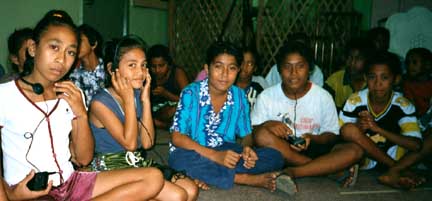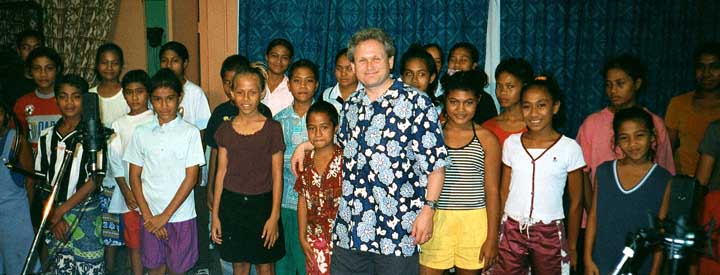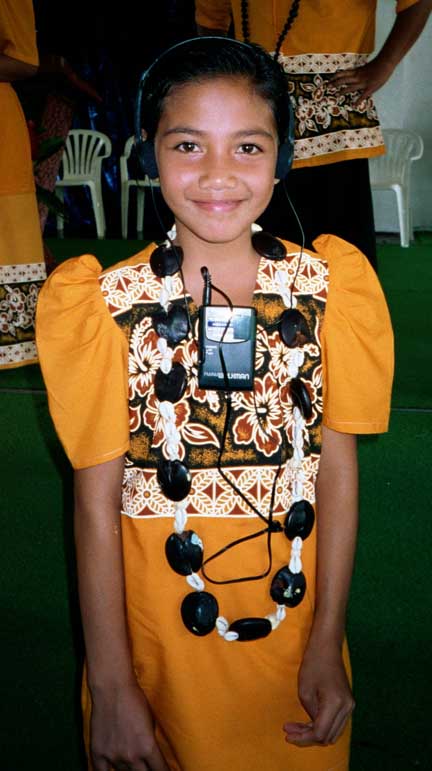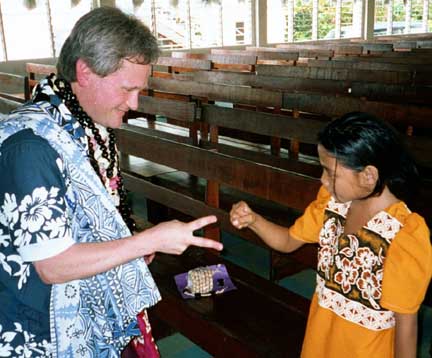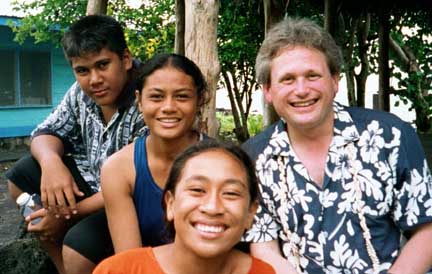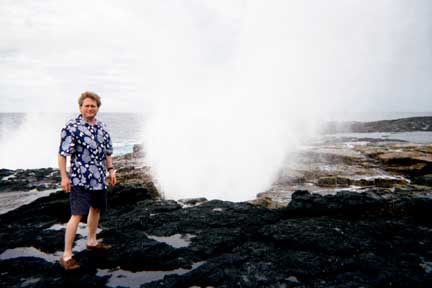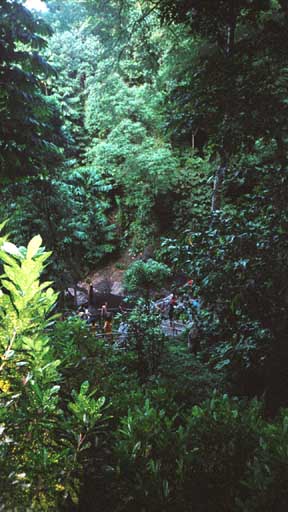In May, 2001, 3D Audio's Lynn Fuston had the opportunity to go to Samoa (Western Samoa) to record a 49 voice children's choir during a video shoot for the Assemblies of God Division of Foreign Missions. This is a narrative account of that trip. Since there are no recording studios in Samoa, I was required to take all the recording gear I needed. This page will include dozens of pictures, some background on the project and the recording gear and techniques used and also an introduction to the culture and people of Samoa. It was a wonderful experience and I hope you will enjoy hearing about the trip as much as I enjoyed learning about this wonderful country in the middle of the South Pacific.
Day 1-Travelling to Samoa
On May 9, at 3:00 PM, I depart Nashville and fly to Los Angeles to join the music producer, Dan Smith (from Dallas, Texas), and the video producer/director, Tim Schirman, and videographer, Frank Gamble (both of Springfield, Missouri) who are the main crew for the video and audio recordings. Our flight is scheduled for departure from LAX at 8:45 PM, with check-in suggested two hours prior to departure for international flights. Dan Smith meets me at the plane from Nashville to help me transport the gear, four suitcases full, which I had checked only to LAX instead of straight to Samoa, so I could see it and make sure it makes the transition to our Air New Zealand flight.
As of 7:15 PM, there is still no sight of Tim or Frank. Dan and I eat dinner and keep an eye out for them. We are very concerned because 1) Tim is the producer, the person who organized the trip and he knows all the contact people and 2) there is only one direct flight from LA to Samoa each week. We were warned in advance that anything we forget to bring will take a week to reach us. Since we will only be there for six days, we will be out of luck. We discuss what we will do if Tim is delayed and doesn't show.
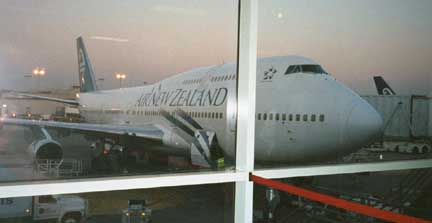
Fortunately at 7.45 PM, Tim and Frank arrive and we all get onto the plane and settle in for our 10-hour flight. The plane is full of mostly New Zealanders, some Samoans and some Americans. For those who don't know where Samoa is located (like me before our trip), from LA you fly over Hawaii (you're halfway there) and almost to New Zealand. It is south of the equator and lies in the 23rd time zone (Nashville is in the 17th), just shy of the International Date Line. It was the last place on earth to exit the 20th century. During our flight, I read up on some literature about Samoa.

Samoa (formerly Western Samoa) is an independent country since 1962, not to be confused with American Samoa which is a neighboring island country that is a U.S. territory. Samoa consists of nine islands, four of which are inhabited, with a total population of 180,000 people. The largest island, Savaii, has 40,000 people and the second largest island, Upolu, has 120,000 people and the capital city of Apia. The currency is the Tala (which is pronounced TAH-luh, and sounds like dollar) and they use the same symbol ($) as Americans do, which makes for some confusion at least to me. The exchange rate is roughly 3:1 (WST$3-Western Samoa Tala = US$1). The people speak their native tongue of Samoan, but many of them also speak English. The climate is tropical (meaning HOT and humid), the average temperature is 82š Fahrenheit, teh average humidity hovers around 90% and there are two seasons-wet and dry. After about an hour of reading, I decide to get some sleep.
Day 2-Arriving in Samoa
I awake at 1:00 AM Samoan time (which is 7:00 AM Nashville time or 5:00 AM LA time-confused yet?) somewhere over the South Pacific. We have breakfast before we touch down in Samoa at 3:00 AM. As I exit the plane, the first thing I notice is the humidity. At the bottom of the metal stairs, I can see wet footprints fanning out across the tarmac reflecting the terminal lights. The metal stairs leading from the plane are wet. There is no sign of rain, but the humidity is so high that any cases that I am carrying are immediately covered with condensation, just like the stairs. It feels like "Casa Blanca" as I walk across the tarmac by the light of the moon.
The Faleolo International Airport terminal is one open building with a high roofline, western construction and murals on the walls. Like most buildings in Samoa, it has no air conditioning. After we clear the passport line, we head to the baggage claim area, another large high-ceilinged room. A wide assortment of baggage is coming off the plane. Among the suitcases, there were large U-Haul boxes, many huge woven coconut mats rolled up and taped shut, even a cellophane-wrapped chrome bumper for a car. I realize for the first time that travellers to Samoa bring everything with them on the plane.
As I stand there watching the baggage carousel, there are only four cases that I care about. If any one of the four is missing, then my trip will be very unproductive. Though I have taken every possible precaution, every single item I brought is necessary to make this recording session work. Since I'm the kind of guy who likes to have a Plan B and a Plan C, and that was not a possibility in this situation, I had said many prayers for my gear to arrive in working condition. So I was nervous, eager, and anxious as I waited for the cases to appear on the baggage carousel. I said still another prayer.
After about 10 mintues, the first one appears. I cheer out loud to the surprise of those around me. Then the second one comes into sight. "We're halfway there!" I exclaim to the rest of the crew. Another minute. Two minutes. Three. Four minutes. No sign of the others. Then finally number 3 comes out, followed closely by number 4. "Yes!!" I proclaim. "Now as long as all of it works..."
By 3:45 AM we have cleared Customs, and then proceed to the main terminal lobby. As I come through the door where a lady is handing out leis (flower garland necklaces) that smell like delicious exotic tropical flowers, I am not prepared for what I see. The entire lobby is packed with people. There are hundreds of men, women and children. Some of the men are dressed up with white shirts and ties along with their lava-lavas (the kilt-like skirt worn by Samoan men), the women are in brightly colored Polynesian dresses and the children are all dressed in very colorful shirts and skirts. I ask Tim why there is so much activity on a small tropical island in the middle of the South Pacific in the middle of the night. "It's an event. Anyone coming from the States this week is arriving now. That's why it's such a big deal." I scurry around the lobby checking out the currency exchange counter, the tourist info desk and the duty free shop and the murals at the far end of the hall, taking in all the sights and sounds, not wanting to miss a thing.
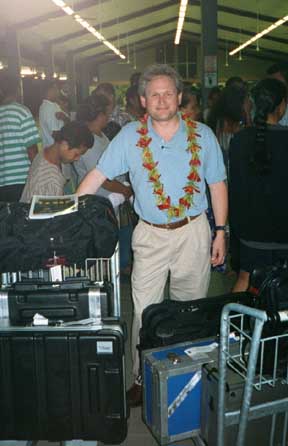
Samoa, 4:00 AM with the portable studio in four cases. This was the ONLY time I wore long pants in Samoa.
It is truly a feast for the senses: the sound of the welcoming crowd, the smell of the flower leis, the colorful clothing and murals on the walls all combine to make it an unforgettable moment. The first of many such moments I will experience over the next few days.
We meet our host, Joe Amosa, who has been watching me flitter around the terminal (I wonder how he knew I was from America? He couldn't see my white legs), and he helps us put our cases into the back of the van. As we pull away from the airport, the breeze blowing in the van windows is a welcome relief from the warm still night air. The half moon is high overhead as we drive the road to Apia, the capital city, about 30 minutes away. As we drive along the edge of the ocean in the moonlight, the sky is clear and all thoughts of sleep escape us. What a beautiful country this is, even by moonlight. There is one incredibly bright star on the horizon, the "Morning Star" according to Joe, but everyone else in the van thinks it's the landing light on a jet because it is so bright. "I bet it's Venus" I say, but they don't believe it's not a plane until 15 minutes later when it has still not moved from its place on the horizon. Joe, a Samoan pastor and our driver and host for the week, is a very likeable guy with a hearty laugh who graciously answers our barrage of questions about Samoa.
We stop for refreshments and bottled water at a small roadside store, one of hundreds that line the roadsides mostly in the front yards of Samoan houses or fales (FAH-lays). We try some local beverages like mango-flavored E2 and Dirty Dog root beer (contains root beer, caffeine and natural amazonian guarana. According to the label "It'll reach and revitalize the places the sun don't shine") and local snacks like fried banana chips and roasted green peas with chili and garlic. As we pull away from the store, Joe tells us that the guy behind the counter is the son of the Speaker of the Samoan Parliament. It's a small world, or rather a small country. There are lots of people up and about, walking on the road sides or waiting for buses, even long before the sky starts to lighten. And there are churches everywhere. I must have seen over 60 during our 26 mile drive. I lost count.
We arrive in Apia and go to the Hotel Tusitala, and check into our rooms. By the time I lay down, it's 5:30 AM and the roosters have been crowing for at least an hour already. The sky is still quite dark and it looks like nighttime even though it feels like day. (It's almost lunch time in Nashville.)
Day 2-After Sunrise
May 10, 8:30 AM.
I'm awake. Wide awake. And it is still thirty minutes before my alarm is set to wake me. As tired as I am, I couldn't go to sleep even after I laid down. My body clock is telling me it's early afternoon and that I should not be sleepy.
I get up and go outside to look around. It's beautiful. There are georgeous trees and flowers that I've never seen before. Everything is so green and lush. There are chickens and dogs everywhere, even on the hotel lawn. And just a few kittens. I shower and dress to go to breakfast. Shorts are definitely the appropriate attire. Even at this early hour, it is warm and humid, though not unpleasantly so.
The breakfast buffet at the hotel offers quite a variety. There are scrambled eggs, pancakes, wonderful hash-brown-like potato pancakes, a gamey tasting bacon, spaghetti (!), beef with pepper and onions, all sorts of tropical fruit and even baklava. The accents of the Samoans and vacationing New Zealanders are all around us and are delightful. The Samoan language is a wonderful soft language. Using many of the same letters as English, but only 17 of them, it is a very pleasing language to hear. We finish eating breakfast, pause for a picture by the pool and pack all the audio and video gear in the van and head to the studio at 11:30 AM.
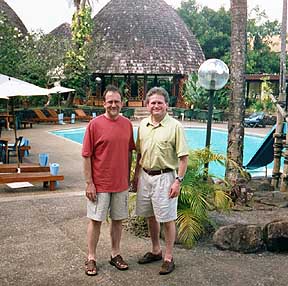
Setup and the First Recording
When we arrive at the TV studio (Samoa's TV Graceland-we'll call it Graceland West to keep from confusing the Elvis fans), we haul in all the gear and begin the process of evaluating the recording space, which none of us has seen before. The key considerations in coming here were 1) it was large enough to hold lots of kids (at one point, we had considered using adjacent hotel rooms for studio and control room) and 2) it has air conditioning, which was important not only for us but for the video and audio equipment as well. The video producer actually had a drive go down on his scouting trip due to the humidity, which is typically above 90% all the time.
The space is large, like a big commercial car garage that will hold 10 cars, with a hard bright sound to match. Ceiling and floor are slabs of concrete (carpet on the floor fortunately) with painted cinder block walls on every side. There are a few partitions, with 10 areas set up as different "sets" for different shows that are produced here. This is, by the way, the only TV studio in all of Samoa. I immediately begin "sussing out" the acoustics by clapping my hands and using sharp consonants to listen for decay times and reflections. I also look around for any absorptive materials that we can use to deaden the very live and very bright space. One corner has curtains on two adjacent walls and I decide to use that as the main recording area. I pull in a wardrobe rack (an iron bar on uprights and casters with clothes on it) which is the most absorptive thing I can find. Two large movable (but reflective) gobos are used to cut off this area from the rest of the room. I ask the studio owner about any packing blankets or quilts to hang from the gobos. He looks at me and laughs. "Blankets? In Samoa?" He must think that I have lost my mind. You see, it never gets below 75š F in Samoa. Ever. No blankets, no sweaters, no long pants, no need. I'm out of luck. But this will work fine. It's large, it's quiet and it's cool by contrast to the outside.
I decide to set up my recording gear in the video control room just adjacent to the studio, so I won't have to worry about drive and fan noise getting into the mics. It's not a soundproof room, but since everyone including myself will be listening on headphones, it's not a problem. One other benefit is that I can have a video monitor feed so I can at least see the conductor and have some communication. That's a nice touch. I also brought along a mic with a switch that I can use for my talkback.
The power in Samoa is 220V at 50 Hz. I was promised power converters so that all my 110V equipment will work. I ask for them and am surprised when I see that they are fist-sized transformers with a power cord hanging out one side and the typical American 110 plug on the other. This is IT? I seriously hope these two will power all the gear that I brought as I start plugging in gear.
So now it's time to start unpacking the gear. This is the REAL moment of truth. The first hurdle was getting it all here on the plane. The second hurdle is getting it out and powering it up, making sure it all still works. It had all worked in my studio just 48 hours and several thousand air miles ago. This is a rental PT system so for my own peace of mind, I had set up everything and verified that it was working the night before I left. Or not working, as was the case with the G3/PT MixPlus system. This was a brand new system, consisting of a G3 Powerbook with a tiny desktop Magma expansion chassis seen below on the left (which holds two PCI cards-Mix Core and Mix Farm) and a 9G SCSI drive. It is connected to the G3 with a Digigram PCM card. I brought an 888/24 for the digital I/O and a Firewire CD recorder for making CDs of our recordings for the video shoot playback.
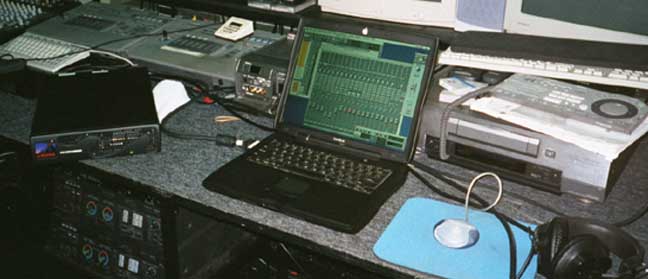
Once the system was delivered to my studio, I plugged it all in, dropped 12 tracks into record, and got the dreaded -6024 error, which translated in layman's terms (for non ProTools people) means "sorry, you can't do that." After several hours troubleshooting, with the owner on the phone for over an hour, we found several settings that were incorrect and then everything was fine, less than 14 hours before I was scheduled to get on the plane. So with all that still on my mind, I say another prayer and start opening up flight cases.
First, it's the 888/24 (seen below), the Rane headphone amp (which will drive the producer's and my headphones) and the Great River MP4MH mic preamp in an SBK flight case.
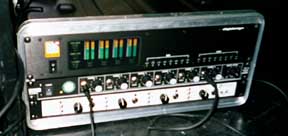
The mics I chose to bring are Audio-Technica mics, a 4060 and two 4050s, which you will see in the pictures with the kids. For headphones, I had considered lots of options, at first considering using earbuds (for their minimal size and weight-remember I will be packing and hauling everything I brought with me) and driving them with a large amp. But cabling and connectors and the consideration of headphone splitters or boxes, plus the weight of an adequate amp made me decide against that method. When I found out that inexpensive headphones cost almost as much as FM Walkmans that include headphones, I developed a new strategy. We would use a small FM stereo transmitter and go wireless with all the headphones. So I purchased 17 Sony FM Walkmans and took a small low-power FM transmitter to broadcast to them. They were all pretuned to a selected frequency and the tuning knobs were taped down.

Once I finish plugging everything in, the moment of truth arrives. I hit the startup key on the G3 and hear the startup chime. What a glorious sound! It makes my heart happy. Thank you God. Then I open the Samoan PT session. Good again. I hit play and slip on my Fostex T20 headphones. Sounds like music. I breathe a sigh of relief.
Everything powers up and works as planned/hoped. Except the transmitter. Aargh! Instead of the 30 feet that I was able to get in the States, it's only reaching barely 8 feet and it sounds bad. Bad enough to be unusable. I try a different frequency and still no go. I decide to power it up again and this time it comes up with no frequency display. Not good. We are so close, yet without headphones this will not work. So close and yet so far. I say another prayer. Frank suggests moving the transmitter out into the studio instead of inside the control room where I am. "Might as well." We move the unit into the studio and power it up. Sure enough, the readout is back and the tuning problem is gone. We check out the headphones and the music is playing through them. YEAH!
We get the mics set up and it's time to start recording some Samoan percussion. These are instruments you may have seen before, save one. Tuned carved wood blocks and large hollow cane blocks. The most interesting instrument which I've never seen before is two liter-size Coke bottles rolled up in a coconut leaf mat (see below). It is hit with sticks and makes a thuddy, clicky sound. Very Samoan. We also decide we need some low end, so Joe Amosa calls the Police Department (the Police Commissioner is a good friend of his) and we borrow the bass drum they use for their marching band. Nice touch. Nice story. Note the conch shell at bottom right. These are used as musical instruments on the islands. I joke about whether there is a conch-shell union in Samoa. I don't think they get it.
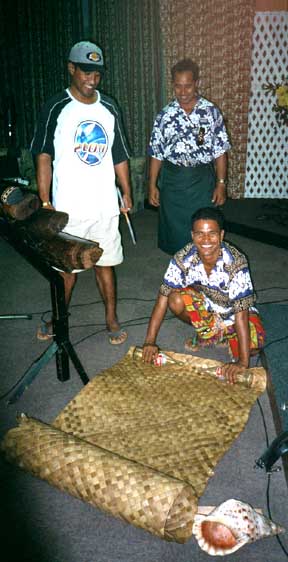
The recording goes smoothly and within an hour and a half, we are done and ahead of schedule. We were supposed to begin recording at 3 PM. It's 3 PM now and we are finished. Good. Now did someone mention LUNCH? Leave it to the engineer to bring it up. I am so relieved that everything is going smoothly, that I don't care about anything else. It's working and I'm happy. It was an ambitious undertaking packing a MixPlus system in four suitcases and travelling to the middle of the South Pacific to record in less than ideal circumstances, most of which were unknowns before I arrived. I am relieved and will sleep well tonight.
Our Samoan percussionist comes in to hear the playback after we are done. A bigger smile I have never seen. He is a very talented musician, who plays drums, percussion, guitar, bass and keyboards and sings. This is probably the first time he has ever heard a recording of himself. His expression says it all. Joe Amosa, our host, is on the right.
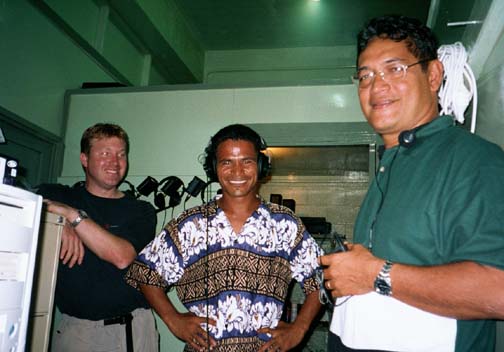
After taking the bass drum back to the Police Headquarters, we head for dinner of fish and chips, which in Samoa is quite good. All the fish is good in Samoa. It doesn't get much fresher than being walking distance from the ocean. And EVERYWHERE on Samoa is walking distance from the ocean.
Here's something interesting I discovered during our late lunch. They don't use ketchup in Samoa. I ask "what is this we are dipping our fries into?" "That is tomato SAUCE." Joe explains that ketchup is an American invention. "You can get ketchup at the only McDonalds in Samoa, here in Apia, but it costs $.20 per packet." Samoans use "tomato sauce" which is a spicy tomato paste, the same consistency as ketchup, but with a spicier flavor. It's like shrimp cocktail sauce without the horseradish. It's quite good, in my opinion preferrable to our ketchup. Sorry Heinz.
After lunch, I go to the Internet Cafe next door and email my family. It seems like a long time since I left them. Actually it's only been 23 hours. But an eventful 23 hours.
Meeting the Kids
After lunch, we go to Joes retreat (a small piece of property with three buildings on it) and meet the 49 kids. When they hear our van coming, they all rush into formation (three lines) and they salute to us as the van pulls up in front of them. Then they break into a song.There are banana and coconut trees behind them and the sun is setting and they are singing and doing hand motions and it's all a magical scene.

The first song is in Samoan. When they finish, their teacher Sara turns to us. "Would you like to hear another?" "Oh yes," we reply. The second song is in their memorized English and it is wonderful as well. "Another?" "Yes, please." As we are serenaded by the smiling children, it is a beautiful and memorable experience, certainly the highlight of the trip so far. But only a foretaste of what is to come.
After they finish their third song, they break rank and rush up to us and each child wants to shake the hands of all four of us. It's like a receiving line, but we are engulfed in the children. "Heh-low," they are all saying. When we have each shaken more than 49 hands (some of the children shake our hands three or four times, coming back through the line), they start asking our names and telling us theirs. They say our names back to us. We try to pronounce their names and they all laugh at our strange pronunciations. "MAH-po, Nah-OO-teh, NEE-fo, Mee-ree-AH-mu, TO-nee." "Tony? Now there's one I recognize."
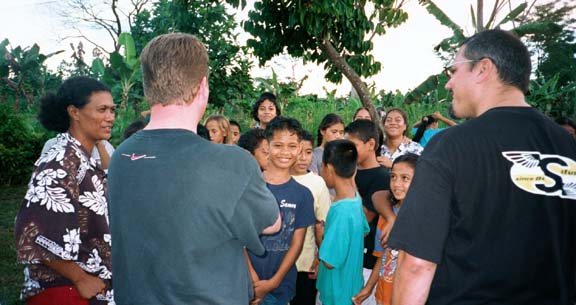
We talk for almost an hour with them, learning names and how to say hello in Samoan. I show them pictures of my five children. They want to know all my children's names. They are so loving and so interested in us. But the sun is setting and it is getting late. The children, who don't live on this island of Upolu, came over by ferry from their village of Iva on the larger island of Savaii. It's been a long day for them and they need to eat and try to sleep. So we say our farewells and climb into the van, after receiving 40 or 50 maybe 60 hugs and we drive away back to the hotel.
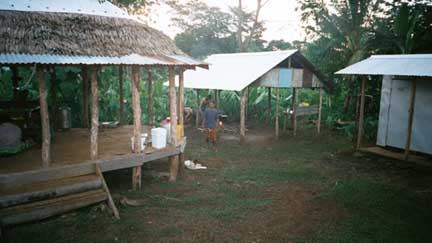
As we pull away from the camp, Joe explains to us: "The children are so excited. They've been practicing with the music for weeks to learn it well. They are camping out here tonight so it's like a big adventure for them. Many of them have never even been to this island before. This is a big deal for them. I hope they are able to sleep."

The beautiful sunset over the georgeous island is delightful. We get back to the hotel, shower and change into fresh clothes (in this humidity, that is something you cannot do enough!), then we head off to Aggie Gray's Hotel, a landmark in the capital city of Apia, and watch a traditional Samoan fire dance. This is an art form in Samoa, where Samoan men in native dress (woven grass skirts) spin and juggle one or two batons with fire on both ends and toss them up in the air and catch them behind their backs and twirl them so fast that your eye only sees a circle of flame. It's an amazing feat, made more spectacular by the fact that there are over a dozen of them doing it simultaneously to the rhythm of a host of island drums. They are standing beside and around the hotel pool in total darkness, with only the light of the fire, and one Samoan is in a canoe on the water. Another runs with his fire up a tree to a balcony and lights the fire for another one, who then tosses it up to another Samoan waiting on the roof and then they all are twirling these flaming batons as the drums build to an enormous crescendo. It is quite an experience.
After the show, it is only 7:45 PM and time for a dinner of prawns and fries (more tomato sauce). We eat under the stars by the swimming pool and I feed prawn tails to the hungry kittens that gather beneath our chairs. They are not bothersome and are very appreciative. As I look up at the enormously bright stars, pondering the fact that there are very few lights on the island and even fewer when you get off the island, I am struck by how much darker the sky is and how much brighter the stars are than where I live. And I'm amazed at how long and full one day can be. It's almost 10 PM now here in Samoa, 4 AM in Nashville where I was just yesterday. I think it's time for bed.
Day 3-Recording the Samoan Kids
Go to Samoa Travelog-Page 2
(More to come as I get time. I've still got 30 more pictures and we're only on Day 3!)
